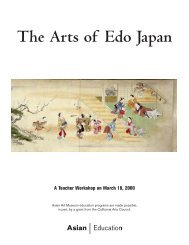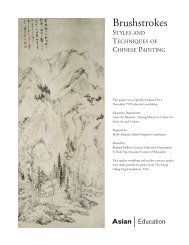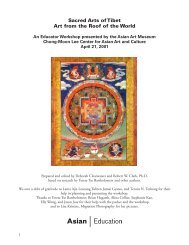China:The Glorious Tang And Song Dynasties - Asian Art Museum ...
China:The Glorious Tang And Song Dynasties - Asian Art Museum ...
China:The Glorious Tang And Song Dynasties - Asian Art Museum ...
You also want an ePaper? Increase the reach of your titles
YUMPU automatically turns print PDFs into web optimized ePapers that Google loves.
Perhaps because Confucian dogma did not approve of female rulers, or even because she had<br />
once lived in a Buddhist convent, Wu Zetian turned to Buddhism to legitimize her rule. Her followers<br />
claimed that Wu Zetian was the incarnation of Maitreya Buddha, the Buddha of the glorious<br />
future age. She promoted gifted Buddhist scholars and patronized the construction of splendid<br />
Buddhist temples and sculptures. Testimonies to her patronage are the rock-cut cave and sculptural<br />
constructions at Longmen, famous for its colossal Buddhist carvings. <strong>The</strong> caves are located near<br />
Luoyang, the eastern capital of <strong>Tang</strong>. At this extensive site, more than 2000 caves and 100,000<br />
sculptures have survived. <strong>The</strong> history of construction at this site began in the last decade of the fifth<br />
century. However, the majority of the cave excavations and sculptures were created during <strong>Tang</strong><br />
dynasty, and among the <strong>Tang</strong> caves, most were crafted during the reign of Wu Zetian under her<br />
sponsorship. In fact, the largest and most celebrated colossal rock-cut sculpture was financed by Wu<br />
Zetian. From her own personal budget, she contributed about 20,000 guan, and she participated in<br />
the consecration ceremony when the statue was complete. Many scholars suspect the image of this<br />
Buddha was modeled on the image of Wu Zetian. (See slide no. 14c in the art section)<br />
Under the patronage of emperors like Wu Zetian, Buddhism flourished in <strong>China</strong>. However,<br />
Buddhism’s relationship with the native culture was not always harmonious. Basic Buddhist teachings<br />
advocating abandoning family and retreating into monasteries directly conflicted with<br />
Confucian dogma, which put emphasis on family duties and harmony among kinships. Buddhism<br />
was also in a competing position with a native religion, Daoism, for followers and patronage. In<br />
addition, Buddhists could not always count on the favor of the emperors. For example, emperor<br />
Wuzong of the <strong>Tang</strong> (840–846) banned Buddhism as a corrupting foreign influence, confiscated the<br />
wealth accumulated by monasteries and shrines, and engineered widespread destruction of Buddhist<br />
temples and sites particularly in southern <strong>China</strong>.<br />
<strong>The</strong> tensions between Buddhism and native culture made Buddhists realize that in order to<br />
flourish in <strong>China</strong>, they needed to adapt to the indigenous cultural context. Gradually, Chinese<br />
Buddhists reconciled Indian teachings with native values and socio-political ideas such as filial piety,<br />
ancestor worship, and social discipline. <strong>The</strong> most distinctive development in this Chinese adaptation<br />
of Buddhism was the rise of Chan Buddhism (known as Zen Buddhism in Japan). Chan<br />
Buddhism, whose name is derived from the Sanskrit word dhyana meaning meditation, emphasized<br />
the practice of meditation and value of monastic discipline over the study of sutras and ritual.<br />
Eventually its practice spread into Korea, Japan, and Vietnam.<br />
According to tradition, an Indian monk named Bodhidharma came to <strong>China</strong> during the fifth<br />
century and established Chan Buddhism in the Shaolin monastery, an institution that is world<br />
famous today for its martial arts. However, the most important figure for the history of Chan<br />
Buddhism in <strong>China</strong> was the sixth patriarch, Huineng (638–713) who lived during the <strong>Tang</strong>.<br />
According to the standard Chan account, Huineng grew up in Guangdong and traveled to Hubei to<br />
pursue religious enlightenment with the fifth patriarch of Chan school, Hongren. Huineng worked<br />
as a humble rice pounder in the monastery. However, when Hongren was looking for his religious<br />
successor, he was greatly impressed by the following stanza Huineng composed:<br />
9
















